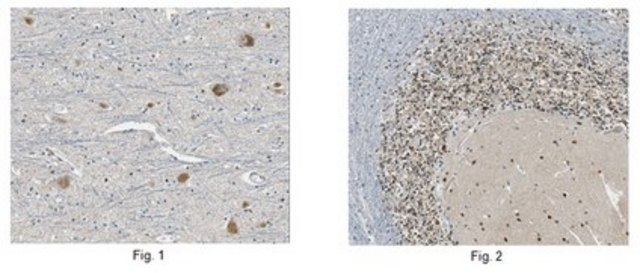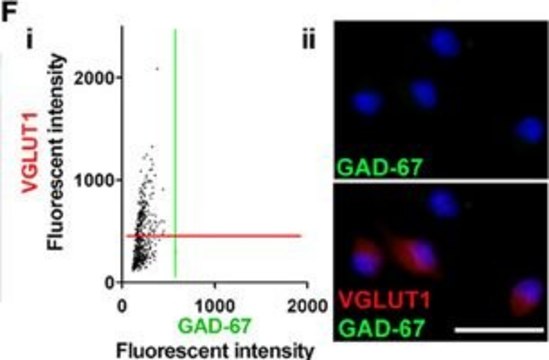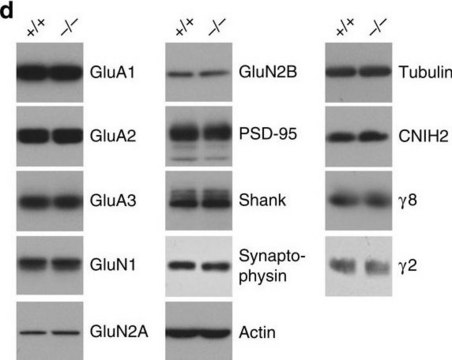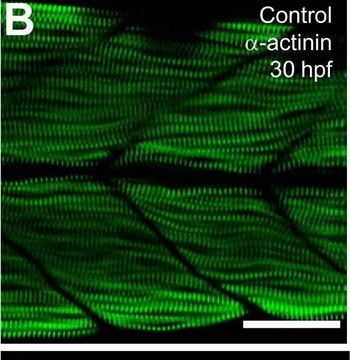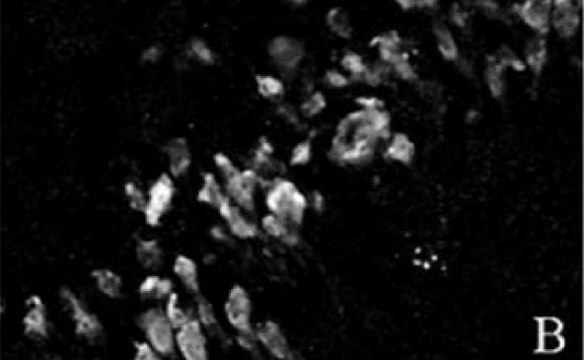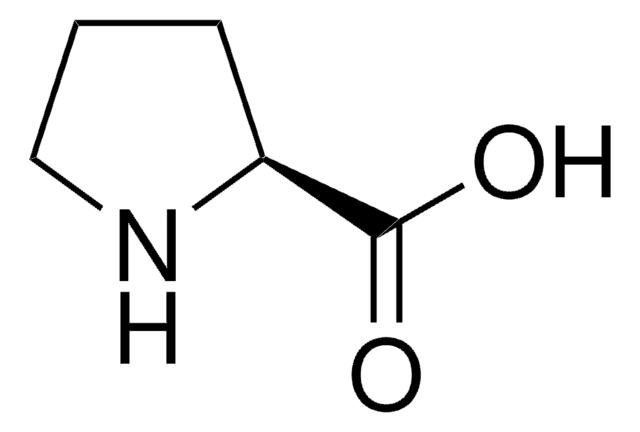Recommended Products
biological source
rabbit
Quality Level
antibody product type
primary antibodies
clone
polyclonal
form
liquid
contains
≤0.1% sodium azide as preservative
species reactivity
rat
manufacturer/tradename
Calbiochem®
storage condition
do not freeze
isotype
IgG
shipped in
wet ice
storage temp.
2-8°C
General description
Anti-GluR1, rabbit polyclonal, recognizes the ~105-107 kDa GluR1 in D425 Med cells and hippocampal neurons. Also cross-reacts with a 50 kDa protein in rat brain. It is validated for WB and IF.
Purified rabbit polyclonal antibody. Recognizes the ~105-107 kDa GluR1 protein.
Recognizes the ~105-107 kDa GluR1 protein in D425 Med cells and hippocampal neurons. Also cross-reacts with a 50 kDa protein in rat brain extracts.
Immunogen
a synthetic peptide (RTSDSRDHTRVDWKR) corresponding to amino acids 271-285 of rat GluR1 (numbered from the signal peptide)
Application
Immunoblotting 1-5 µg/ml)
Immunofluorescence (10-20 µg/ml, see application references)
Immunofluorescence (10-20 µg/ml, see application references)
Packaging
Please refer to vial label for lot-specific concentration.
Warning
Toxicity: Standard Handling (A)
Analysis Note
Positive Control
D425 Med cells, hippocampal neurons
D425 Med cells, hippocampal neurons
Other Notes
Also recognizes a smaller band at ~50 kDa using whole brain extracts. Immunofluorescence of dissociated cultured rat hippocampal neurons gave a punctate distribution, consistent with previous reports of GluR1 distribution. Antibody should be titrated for optimal results in individual systems.
Zuo, J. et al. 1997. Nature388, 769.
McHugh, T.J., et al. 1996. Cell87, 1339.
Tsien, J.Z., et al. 1996. Cell87, 1327.
Greenamyre, J.T. and Porter, R.H.P. 1994. Neurology44, S7.
Hollmann, M. and Heinemann, S. 1994. Ann. Rev. Neurosci.17, 31.
Bliss, T.V.P. and Collingridge, G.L. 1993. Nature361, 31.
Lomeli, H., et al. 1993. FEBS Lett.315, 318.
Molnar, E. et al. 1993. Neuroscience53, 307.
Advokat, C. and Pellegrin, A.I. 1992. Neurosci. Biobehav. Rev.16, 13.
Beal, M.F. 1992. FASEB J.6, 3338.
Rothman, S.M. 1992. Ann. NY Acad. Sci.648, 132.
McHugh, T.J., et al. 1996. Cell87, 1339.
Tsien, J.Z., et al. 1996. Cell87, 1327.
Greenamyre, J.T. and Porter, R.H.P. 1994. Neurology44, S7.
Hollmann, M. and Heinemann, S. 1994. Ann. Rev. Neurosci.17, 31.
Bliss, T.V.P. and Collingridge, G.L. 1993. Nature361, 31.
Lomeli, H., et al. 1993. FEBS Lett.315, 318.
Molnar, E. et al. 1993. Neuroscience53, 307.
Advokat, C. and Pellegrin, A.I. 1992. Neurosci. Biobehav. Rev.16, 13.
Beal, M.F. 1992. FASEB J.6, 3338.
Rothman, S.M. 1992. Ann. NY Acad. Sci.648, 132.
Legal Information
CALBIOCHEM is a registered trademark of Merck KGaA, Darmstadt, Germany
Regulatory Information
监管及禁止进口产品
Certificates of Analysis (COA)
Search for Certificates of Analysis (COA) by entering the products Lot/Batch Number. Lot and Batch Numbers can be found on a product’s label following the words ‘Lot’ or ‘Batch’.
Already Own This Product?
Find documentation for the products that you have recently purchased in the Document Library.
Michael Notaras et al.
Molecular psychiatry, 25(12), 3360-3379 (2019-10-23)
Synaptic plasticity requires a tight control of mRNA levels in dendrites. RNA translation and degradation pathways have been recently linked to neurodevelopmental and neuropsychiatric diseases, suggesting a role for RNA regulation in synaptic plasticity and cognition. While the local translation
David S Tukey et al.
The Journal of biological chemistry, 288(49), 35297-35306 (2013-10-18)
Regulation of striatal medium spiny neuron synapses underlies forms of motivated behavior and pathological drug seeking. A primary mechanism for increasing synaptic strength is the trafficking of α-amino-3-hydroxy-5-methyl-4-isoxazolepropionic acid receptors (AMPARs) into the postsynapse, a process mediated by GluA1 AMPAR
Dhrubajyoti Chowdhury et al.
Frontiers in synaptic neuroscience, 11, 6-6 (2019-03-28)
AMPA-type glutamate receptors (AMPARs) are clustered into functional nanodomains at postsynaptic sites through anchorage by the scaffolding protein, postsynaptic density protein-95 (PSD-95). The synaptic abundance of AMPARs is dynamically controlled in various forms of synaptic plasticity. Removal of AMPARs from
Jessica A Loweth et al.
The European journal of neuroscience, 50(3), 2590-2601 (2018-09-18)
In several brain regions, ongoing metabotropic glutamate receptor 1 (mGlu1) transmission has been shown to tonically suppress synaptic levels of Ca2+ -permeable AMPA receptors (CP-AMPARs) while pharmacological activation of mGlu1 removes CP-AMPARs from these synapses. Consistent with this, we previously
Huong T T Ha et al.
Frontiers in molecular neuroscience, 11, 405-405 (2018-12-14)
During development, pyramidal neurons undergo dynamic regulation of AMPA receptor (AMPAR) subunit composition and density to help drive synaptic plasticity and maturation. These normal developmental changes in AMPARs are particularly vulnerable to risk factors for Autism Spectrum Disorders (ASDs), which
Our team of scientists has experience in all areas of research including Life Science, Material Science, Chemical Synthesis, Chromatography, Analytical and many others.
Contact Technical Service